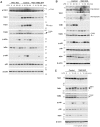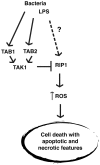Activated macrophage survival is coordinated by TAK1 binding proteins
- PMID: 24736749
- PMCID: PMC3988229
- DOI: 10.1371/journal.pone.0094982
Activated macrophage survival is coordinated by TAK1 binding proteins
Abstract
Macrophages play diverse roles in tissue homeostasis and immunity, and canonically activated macrophages are critically associated with acute inflammatory responses. It is known that activated macrophages undergo cell death after transient activation in some settings, and the viability of macrophages impacts on inflammatory status. Here we report that TGFβ- activated kinase (TAK1) activators, TAK1-binding protein 1 (TAB1) and TAK1-binding protein 2 (TAB2), are critical molecules in the regulation of activated macrophage survival. While deletion of Tak1 induced cell death in bone marrow derived macrophages even without activation, Tab1 or Tab2 deletion alone did not profoundly affect survival of naïve macrophages. However, in lipopolysaccharide (LPS)-activated macrophages, even single deletion of Tab1 or Tab2 resulted in macrophage death with both necrotic and apoptotic features. We show that TAB1 and TAB2 were redundantly involved in LPS-induced TAK1 activation in macrophages. These results demonstrate that TAK1 activity is the key to activated macrophage survival. Finally, in an in vivo setting, Tab1 deficiency impaired increase of peritoneal macrophages upon LPS challenge, suggesting that TAK1 complex regulation of macrophages may participate in in vivo macrophage homeostasis. Our results demonstrate that TAB1 and TAB2 are required for activated macrophages, making TAB1 and TAB2 effective targets to control inflammation by modulating macrophage survival.
Conflict of interest statement
Figures







Similar articles
-
Interleukin-1 and TRAF6-dependent activation of TAK1 in the absence of TAB2 and TAB3.Biochem J. 2017 Jun 26;474(13):2235-2248. doi: 10.1042/BCJ20170288. Biochem J. 2017. PMID: 28507161 Free PMC article.
-
TAK1-binding protein 2 (TAB2) and TAB3 are redundantly required for TLR-induced cytokine production in macrophages.Int Immunol. 2024 Aug 13;36(9):439-450. doi: 10.1093/intimm/dxae020. Int Immunol. 2024. PMID: 38567483
-
Epithelial transforming growth factor β-activated kinase 1 (TAK1) is activated through two independent mechanisms and regulates reactive oxygen species.Proc Natl Acad Sci U S A. 2012 Feb 28;109(9):3365-70. doi: 10.1073/pnas.1116188109. Epub 2012 Feb 13. Proc Natl Acad Sci U S A. 2012. PMID: 22331902 Free PMC article.
-
Post-Translational Modifications of the TAK1-TAB Complex.Int J Mol Sci. 2017 Jan 19;18(1):205. doi: 10.3390/ijms18010205. Int J Mol Sci. 2017. PMID: 28106845 Free PMC article. Review.
-
TAK1-TABs Complex: A Central Signalosome in Inflammatory Responses.Front Immunol. 2021 Jan 5;11:608976. doi: 10.3389/fimmu.2020.608976. eCollection 2020. Front Immunol. 2021. PMID: 33469458 Free PMC article. Review.
Cited by
-
TAK1 regulates resident macrophages by protecting lysosomal integrity.Cell Death Dis. 2017 Feb 9;8(2):e2598. doi: 10.1038/cddis.2017.23. Cell Death Dis. 2017. PMID: 28182011 Free PMC article.
-
TAK1 inhibition attenuates both inflammation and fibrosis in experimental pneumoconiosis.Cell Discov. 2017 Jul 11;3:17023. doi: 10.1038/celldisc.2017.23. eCollection 2017. Cell Discov. 2017. PMID: 28698801 Free PMC article.
-
MicroRNA 27a-3p Regulates Antimicrobial Responses of Murine Macrophages Infected by Mycobacterium avium subspecies paratuberculosis by Targeting Interleukin-10 and TGF-β-Activated Protein Kinase 1 Binding Protein 2.Front Immunol. 2018 Jan 11;8:1915. doi: 10.3389/fimmu.2017.01915. eCollection 2017. Front Immunol. 2018. PMID: 29375563 Free PMC article.
-
Induction of Macrophage Function in Human THP-1 Cells Is Associated with Rewiring of MAPK Signaling and Activation of MAP3K7 (TAK1) Protein Kinase.Front Cell Dev Biol. 2016 Mar 30;4:21. doi: 10.3389/fcell.2016.00021. eCollection 2016. Front Cell Dev Biol. 2016. PMID: 27066479 Free PMC article.
-
Current translational potential and underlying molecular mechanisms of necroptosis.Cell Death Dis. 2019 Nov 12;10(11):860. doi: 10.1038/s41419-019-2094-z. Cell Death Dis. 2019. PMID: 31719524 Free PMC article. Review.
References
Publication types
MeSH terms
Substances
Grants and funding
LinkOut - more resources
Full Text Sources
Other Literature Sources
Molecular Biology Databases
Research Materials
Miscellaneous

